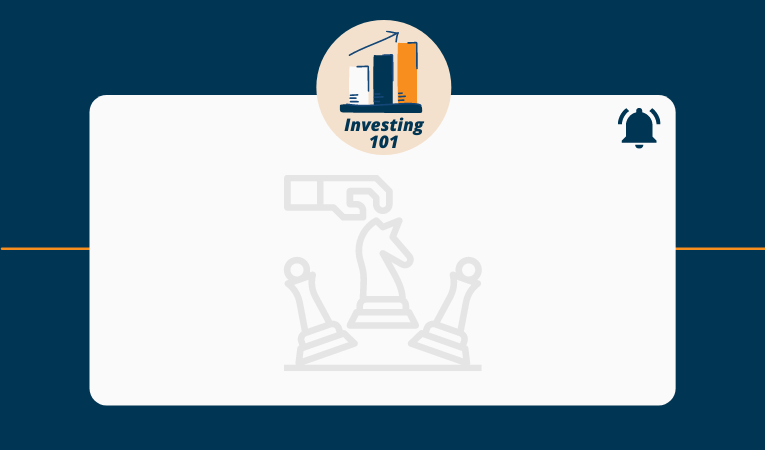Investing 101 Part 5: 5 Basic Investment Strategies for Beginners August 11, 2021

By now, you should have built a resource library, opened an online brokerage account, and perhaps contemplated dipping your toes into some blue chips or ETFs. Are you then eager to start investing?
Today’s Investing 101 introduces you to five basic investment strategies for beginners.
As you digest the information, bear in mind that there is no one best investment strategy.
The truth is that markets ebb and flow and investors are not as rational as we would like to think. We may become overly optimistic when times are good and overly pessimistic when the economy and markets lose steam.
When the unexpected happens, remain calm. Remember Warren Buffett’s golden advice, “Be fearful when others are greedy and greedy when others are fearful.” Greed drives asset prices up while fear causes asset prices to dip. As counterintuitive as it sounds, economic downturns could be perfect buying opportunities!
Being aware of these fundamental investment strategies can help you develop a go-to investing approach. You may even combine strategies, depending on market conditions and your investment goals. Think of today’s Investing 101 as a starting point for your investment journey.
Let’s begin!
1. Dollar-cost averaging
Dollar-cost averaging is a strategy where small amounts of money are invested regularly in an asset. For instance, investing S$100 every month in a stock for a year is a form of dollar-cost averaging. You buy more of the stock when prices are low and you cut your purchases when prices are high. Due to your commitment to make consistent investments, your price per share eventually averages out.
To maximise returns with dollar-cost averaging, you could invest more regularly when opportunities arise and cut back when prices rebound. Opportunities arise when prices dip or when markets crash.
Over time, dollar-cost averaging reduces your exposure to price volatility. You no longer try to predict market movements. Instead, you are in it for the long haul.
Read more here: 3 Reasons Why Dollar-Cost Averaging is a Smart Investment Strategy
2. Diversification
Diversifying investments means buying assets in different asset classes or across industries and markets.
Your asset holdings should ideally not dip together when times are bad. Instead, you want to hold some assets that will still stay profitable even when other asset prices are down.
For instance, if a pandemic hits air travel and causes airline stocks to nosedive, airline stocks will likely dip across the board. If you have not diversified your portfolio, you would book losses from all your investments!
Diversification makes your investment portfolio more resistant to singular events.
Do you now see why ETFs are useful? They are one way of diversifying your investments. An example of an ETF is the SPDR S&P 500, which tracks the S&P’s 500 large- and mid-cap US stocks. In Singapore, the STI ETF provides exposure to a basket of blue-chip companies listed on the SGX.
Read more here: 10 Types of Investments for Beginners
3. Rule of 40 for stock picking
If a software company is in its initial growth stage, most of its profits are probably reinvested back in the business. This is because new businesses need to spend a fair bit of money to build market share so that they have the critical mass to turn profitable at some point. That being the case, how do you decide whether to purchase its stock?
The Rule of 40 can guide you. Under the rule, you may invest in this software company if its revenue growth rate and profit margins add up to more than 40%. The next time someone advises you to purchase the stock of a high-growth company, use the Rule of 40 to decide if the investment is worth your risk!
Read more here: Rule of 40 for Stock Selection
4. Technical analysis
Basic knowledge of technical analysis is useful for all investors. Technical charts can help you verify what financial analysis concludes about an asset or market trends.
Charts provide data on historical performance and the information extrapolated can provide some indication of how prices will move in the short term.
Stock investors can also apply technical analysis to different stocks to evaluate recent price movements, and therefore, infer their relative strengths and weaknesses.
Some basic terms in technical analysis are head and shoulders, support and resistance, and double top reversal. Sounds alien? Check out the link below for more detailed explanations and illustrations! You may also be interested in our weekly technical analysis webinars where our analysts interpret charts and share their latest insights on US markets.
Again, bear in mind that chart predictions are not foolproof. Over the long term, they are subject to even more unpredictable variables. Mostly, technical analysis aids in short-term analysis and less so for longer time horizons.
Read more here: 3 Powerful Risk Management Strategies Using Technical Analysis
5. 4-3-2-1 budgeting rule
As new investors, how do we decide the amount to save or invest?
The 4-3-2-1 framework provides a simple guideline. It limits your spending in each category. Under this framework, 40% of your budget should go to daily expenses, 30% to loan repayments, 20% to savings or investments, and finally, 10% to insurance.
The 4-3-2-1 budgeting rule can help you decide how much to invest each month!
Watch the explainer video here: Personal Budgeting – 4-3-2-1 Rule
To recap, these are the 5 basic investment strategies:
1. Dollar-cost averaging
2. Diversification
3. Rule of 40 for stock picking
4. Technical analysis
5. 4-3-2-1 budgeting rule
There is no cookie-cutter investment approach for all investors. You have to make a judgment call based on all the information that is available to you. The 5 strategies are also not mutually exclusive and you may mix and match for your optimal investment outcomes.
Want to learn more investment strategies? Register for our free webinars here and learn from our professional dealers, analysts and industry veterans today!
Now that you have learned the 5 basic investment strategies, are you ready to invest? Open a POEMS account to start trading or chat with one of our licensed representatives to find out more.
Alternatively, join our Global Markets Investment Community on Telegram to share your views and experiences with like-minded investors!
Disclaimer
These commentaries are intended for general circulation. It does not have regard to the specific investment objectives, financial situation and particular needs of any person who may receive this document. Accordingly, no warranty whatsoever is given and no liability whatsoever is accepted for any loss arising whether directly or indirectly as a result of any person acting based on this information. Opinions expressed in these commentaries are subject to change without notice. Investments are subject to investment risks including the possible loss of the principal amount invested. The value of the units and the income from them may fall as well as rise. Past performance figures as well as any projection or forecast used in these commentaries are not necessarily indicative of future or likely performance. Phillip Securities Pte Ltd (PSPL), its directors, connected persons or employees may from time to time have an interest in the financial instruments mentioned in these commentaries. Investors may wish to seek advice from a financial adviser before investing. In the event that investors choose not to seek advice from a financial adviser, they should consider whether the investment is suitable for them.
The information contained in these commentaries has been obtained from public sources which PSPL has no reason to believe are unreliable and any analysis, forecasts, projections, expectations and opinions (collectively the “Research”) contained in these commentaries are based on such information and are expressions of belief only. PSPL has not verified this information and no representation or warranty, express or implied, is made that such information or Research is accurate, complete or verified or should be relied upon as such. Any such information or Research contained in these commentaries are subject to change, and PSPL shall not have any responsibility to maintain the information or Research made available or to supply any corrections, updates or releases in connection therewith. In no event will PSPL be liable for any special, indirect, incidental or consequential damages which may be incurred from the use of the information or Research made available, even if it has been advised of the possibility of such damages. The companies and their employees mentioned in these commentaries cannot be held liable for any errors, inaccuracies and/or omissions howsoever caused. Any opinion or advice herein is made on a general basis and is subject to change without notice. The information provided in these commentaries may contain optimistic statements regarding future events or future financial performance of countries, markets or companies. You must make your own financial assessment of the relevance, accuracy and adequacy of the information provided in these commentaries.
Views and any strategies described in these commentaries may not be suitable for all investors. Opinions expressed herein may differ from the opinions expressed by other units of PSPL or its connected persons and associates. Any reference to or discussion of investment products or commodities in these commentaries is purely for illustrative purposes only and must not be construed as a recommendation, an offer or solicitation for the subscription, purchase or sale of the investment products or commodities mentioned.
About the author
Ng Ming Qian (Intern) & Joel Lim (ETF Specialist)
Ming Qian is an intern from the Global Markets Desk at Phillip Securities and an Economics Undergraduate at the National University of Singapore. Outside of school, Ming Qian hustles as a freelance writer and blogger who simplifies complex topics for readers. When he is not writing or buried in his books, you can probably find him tending to his aroid plants or bingeing on Grey’s Anatomy.
Joel is the ETF Specialist from the ETF desk in Phillip Securities. He helps to provide sales support and trading ideas to retail investors, remisiers, in-house dealers, and fund managers. Joel also works closely with ETF issuers on new product and business development projects.

 Back in Business: The Return of IPOs & Top Traded Counters in March 2024
Back in Business: The Return of IPOs & Top Traded Counters in March 2024  From $50 to $100: Unveiling the Impact of Inflation
From $50 to $100: Unveiling the Impact of Inflation  Japan’s Economic Resurgence: Unveiling the Tailwinds Behind Nikkei 225’s Record Leap
Japan’s Economic Resurgence: Unveiling the Tailwinds Behind Nikkei 225’s Record Leap  How to soar higher with Positive Carry!
How to soar higher with Positive Carry! 









